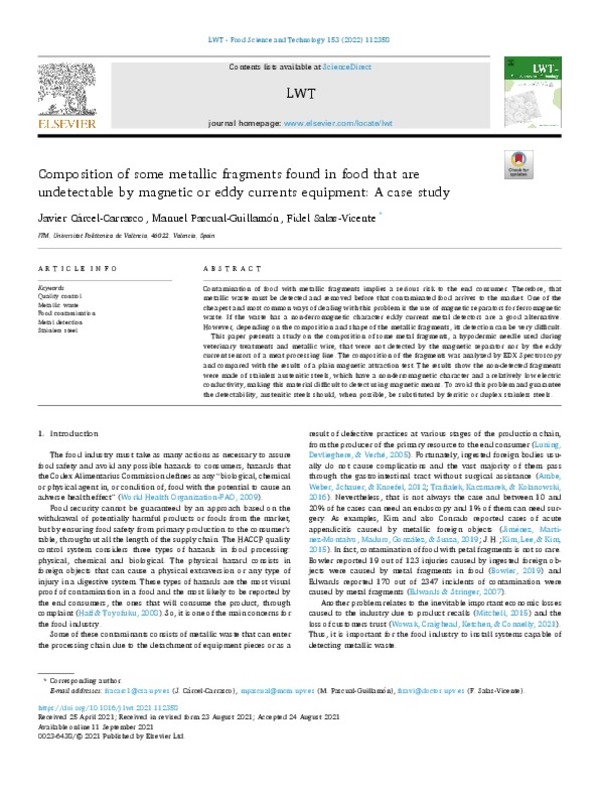JavaScript is disabled for your browser. Some features of this site may not work without it.
Buscar en RiuNet
Listar
Mi cuenta
Estadísticas
Ayuda RiuNet
Admin. UPV
Composition of some metallic fragments found in food that are undetectable by magnetic or eddy currents equipment: A case study
Mostrar el registro sencillo del ítem
Ficheros en el ítem
| dc.contributor.author | Cárcel-Carrasco, Javier
|
es_ES |
| dc.contributor.author | Pascual Guillamón, Manuel
|
es_ES |
| dc.contributor.author | Salas Vicente, Fidel
|
es_ES |
| dc.date.accessioned | 2022-03-08T19:03:36Z | |
| dc.date.available | 2022-03-08T19:03:36Z | |
| dc.date.issued | 2022-01 | es_ES |
| dc.identifier.issn | 0023-6438 | es_ES |
| dc.identifier.uri | http://hdl.handle.net/10251/181316 | |
| dc.description.abstract | [EN] Contamination of food with metallic fragments implies a serious risk to the end consumer. Therefore, that metallic waste must be detected and removed before that contaminated food arrives to the market. One of the cheapest and most common ways of dealing with this problem is the use of magnetic separators for ferromagnetic waste. If the waste has a non-ferromagnetic character eddy current metal detectors are a good alternative. However, depending on the composition and shape of the metallic fragments, its detection can be very difficult. This paper presents a study on the composition of some metal fragments, a hypodermic needle used during veterinary treatments and metallic wire, that were not detected by the magnetic separator nor by the eddy current sensors of a meat processing line. The composition of the fragments was analyzed by EDX Spectroscopy and compared with the results of a plain magnetic attraction test. The results show the non-detected fragments were made of stainless austenitic steels, which have a non-ferromagnetic character and a relatively low electric conductivity, making this material difficult to detect using magnetic means. To avoid this problem and guarantee the detectability, austenitic steels should, when possible, be substituted by ferritic or duplex stainless steels. | es_ES |
| dc.language | Inglés | es_ES |
| dc.publisher | Elsevier | es_ES |
| dc.relation.ispartof | LWT - Food Science and Technology | es_ES |
| dc.rights | Reconocimiento - No comercial - Sin obra derivada (by-nc-nd) | es_ES |
| dc.subject | Quality control | es_ES |
| dc.subject | Metallic waste | es_ES |
| dc.subject | Food contamination | es_ES |
| dc.subject | Metal detection | es_ES |
| dc.subject | Stainless steel | es_ES |
| dc.title | Composition of some metallic fragments found in food that are undetectable by magnetic or eddy currents equipment: A case study | es_ES |
| dc.type | Artículo | es_ES |
| dc.identifier.doi | 10.1016/j.lwt.2021.112358 | es_ES |
| dc.rights.accessRights | Abierto | es_ES |
| dc.description.bibliographicCitation | Cárcel-Carrasco, J.; Pascual Guillamón, M.; Salas Vicente, F. (2022). Composition of some metallic fragments found in food that are undetectable by magnetic or eddy currents equipment: A case study. LWT - Food Science and Technology. 153:1-5. https://doi.org/10.1016/j.lwt.2021.112358 | es_ES |
| dc.description.accrualMethod | S | es_ES |
| dc.relation.publisherversion | https://doi.org/10.1016/j.lwt.2021.112358 | es_ES |
| dc.description.upvformatpinicio | 1 | es_ES |
| dc.description.upvformatpfin | 5 | es_ES |
| dc.type.version | info:eu-repo/semantics/publishedVersion | es_ES |
| dc.description.volume | 153 | es_ES |
| dc.relation.pasarela | S\445611 | es_ES |








